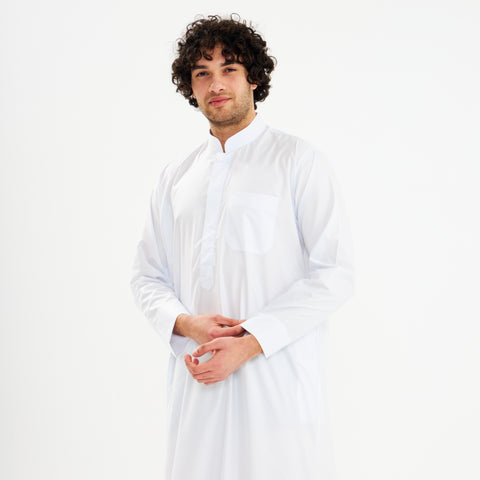Different Types of Thobes
In the rich tapestry of Muslim culture, one garment stands out for its elegance, simplicity and deep-seated tradition: the thobe. Known variously as a jubba, kandora, djellaba, jalabiya, qamis or dishdasha depending on the region, this traditional ankle-length robe has been a staple of male attire in the Muslim world for centuries.
Originating from the hot and arid climates of the Middle East, the thobe was designed to be both modest and comfortable, protecting the wearer from the harsh sun while adhering to Islamic principles. If you’ve ever been lucky enough to wear one in the blistering heat of summertime Dubai, you’ll know what difference it makes.
As times have evolved, so too has the humble thobe. No longer just a symbol of tradition and religious observance, it has seamlessly merged with the worlds of fashion and style. Today’s thobes come in a dazzling array of styles, materials, stitching and embellishments, each reflecting the rich diversity of Islamic heritage while adhering to contemporary trends.
Let’s dive into some of these fashionable variations that are making waves among Muslim men globally.
Kuwaiti and Yemeni dishdasha
Characterised by its loose fit and lightweight fabric, the Kuwaiti and Yemeni dishdasha is made for comfort. They are often tailored to incorporate traditional elements with a touch of modern flair, but many wearers just like them to be as simple as possible, with no embellishment at all – just single-coloured fabric and no collar detail. These dishdashas are perfect for both everyday wear and special occasions.

Emirati and Omani kandora
The kandora from the UAE and Oman takes elegance to the next level with its sleek design and subtle embellishments. The Emirati version is noted for its no-collar style and high-quality fabrics, while the Omani kandora (or kandura) often features a tassel hanging from the neckline – a distinctive touch. Both styles focus on clean lines and understated elegance, making them a favourite for formal gatherings.

Saudi Arabian thobe
The Saudi Arabian thobe is perhaps the most recognised style internationally. With its sharp collar and crisp fabrics, it exudes sophistication. This version often includes minimalist stitching along the chest and cuffs, delivering a clean, refined look that’s perfect for both business settings and social events. In its native lands it’s usually accompanied by a keffiyeh, but in the West it can be a standalone garment, with perhaps a nod to the wearer’s ancestry or nationality.
Moroccan thobe
Venturing into North Africa, Moroccan thobes (or djellabas) introduce us to a world of colour and pattern. Made from heavier fabrics to suit the cooler climate, these garments feature bold geometric patterns that’s instantly associated with Moroccan art and architecture. There’s often intricate embroidery, and sometimes a looser, hooded design. Moroccan thobes are a colourful celebration of Islamic culture and craftsmanship.
South Asian thobe
The South Asian variation brings its unique flair through bright colours and elaborate patterns. This region’s love for intricate embroidery is evident in its thobes, with detailed work running down the front panel or around the neck. Fabrics range from simple cottons to rich silks, accommodating various climates, levels of wealth and occasions.
Casual thobe
For those days when comfort is key but you still want to nod to tradition, the casual thobe is your go-to. Made from softer, more breathable fabrics like cotton blends, these thobes are ideal for everyday wear. Simplicity reigns supreme here, with minimal stitching or embroidery, reflecting a laid-back yet respectful style.
The casual thobe can take influence from any of the styles detailed above. Pick a casual thobe depending on your likely activity: slimmer and stiffer for relaxing with family or friends; looser and lighter for more active pursuits, especially in warmer climes.
A note on colour
Colour has always played a part in the thobe. Since the cities of the Middle East have long been hubs for trade and experimentation, an array of dyes and fabrics has passed through the region’s bazaars and trading posts for millennia. Colour would have reflected wealth and fashion, just as a perfectly clean white thobe would have. Purple and blue were particularly rare and prized.
Nowadays, dyes of any colour are not an indicator of wealth or status. But the culture of dyeing and embellishing thobes with colour fabric or detailing remains part of the look. Since colour has been present in the thobe wherever it has been worn, there are no rules about colour – just wear what you feel comfortable in.
If you’re going for a cool, casual look in a hot climate, we strongly recommend white, however. It’s great at reflecting light and heat, while darker colours would absorb it, potentially making you uncomfortably warm.
Our region-spanning thobe collection
Now you’re up to speed on what the thobe represents, it’s time to select the one that’s just for you. Whether you’re looking for something to reflect your heritage, are shopping for a special occasion, or simply want casual wear to look your best in, you’ll find a high-quality thobe that suits you perfectly in our extensive collection.